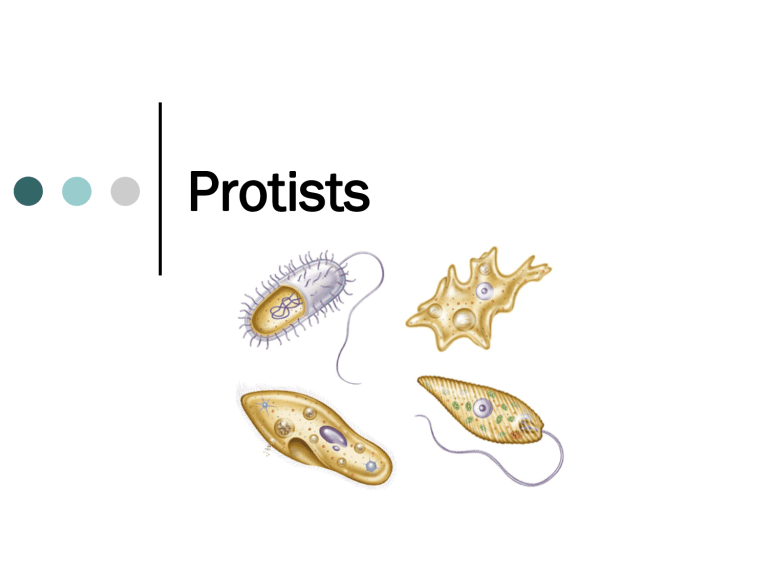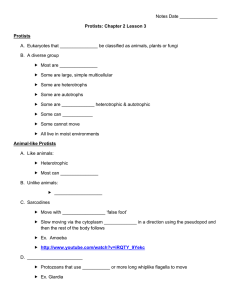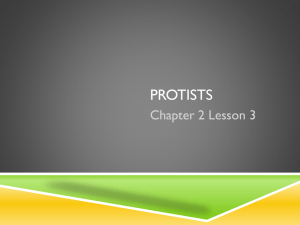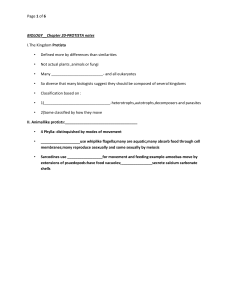think!

Protists
What is a Protist?
The Protist Kingdom is also known as the “ Junk Drawer Kingdom”.
THINK! What does this nickname imply about the kingdom?
The organisms in this kingdom are so different from each other
However, all protists do share 2 characteristics
They all have a nucleus
They all live in moist surroundings
Protist Groupings
Because protists are such a diverse group, scientists group them into 3 different categories:
Animal-like Protists
Plant-like Protists
Fungus-like Protists
THINK!
– What characteristics do you think all animal-like protists share?
All are heterotrophs and
can move from one place to another
THINK!
– What characteristic do you think all plant-like protists share?
All are autotrophs
THINK!
– What characteristics do you think all fungus-like protists share?
All are heterotrophs, have cell walls, and reproduce by spores
Animal-like Protists
Amoebas
Cell Structure: These are unicellular organisms.
Movement: They move with a pseudopod , meaning “false foot.” This is when the cell membrane fills with cytoplasm and pushes forward. They are known as shape shifters as they constantly change their shape by cytoplasmic streaming .
Nutrition: They eat bacteria and other small protists using pseudopods to surround, or engulf , the food into a new food vacuole. Excess water is controlled and expelled from an amoeba through a contractile vacuole.
• THINK! Are they heterotrophic or autotrophic?
Reproduction : Amoebas reproduce by binary fission.
Take a Look at an Amoeba’s Structure!
United Streaming Clip on Amoebas!
Monsters Inside Me – Brain Eating Amoeba http://animal.discovery.com/videos/monsters-inside-me-the-braineating-amoeba.html
Animal-like Protists
Paramecium
Cell Structure : These are unicellular organisms that have an outer pellicle .
Movement: They move with tiny hairlike projections called cilia that cover the entire cell. Think of cilia as “ tiny oars ” that help to propel the cell forward.
Nutrition : Cilia sweep food such as bacteria and other small protists into the cell. Food is stored and digested in food vacuoles .
• THINK!
– Are paramecia heterotrophic or autotrophic?
Reproduction : Paramecia usually reproduce by binary fission but occasionally use conjugation to mix up the genes and increase genetic diversity.
Let’s Take a look at a Paramecium!
United Streaming Clip on Paramecium!
Paramecium Eating Pigmented Yeast http://www.youtube.com/watch?v=l9ymaSzcsdY&feature=related
Paramecium in HD http://www.youtube.com/watch?v=a4aZE5FQ284&feature=fvwrel
Plant-like Protists
Euglenoids
Cell Structure: These are unicellular organisms.
Movement: They move by using a flagellum.
Nutrition: They contain chloroplasts which capture sunlight and turn it into food. However, sometimes when there is no light, they must seek out their food. An eyespot senses light.
• THINK! Are they heterotrophic or autotrophic?
Reproduction : Euglenas reproduce by binary fission
Let’s look at the Structure of A Euglena
United Streaming Clip on Euglena!
Euglena Movement http://www.youtube.com/watch?v=fI7nEWUjk3A
Euglena Under Microscope http://www.youtube.com/watch?feature=endscreen&v=4MlR3dKfXmc&NR=
1
Plant-like Protists
Diatoms
Cell Structure: These are unicellular with beautifull glass-like cell walls. Their shells are used in toothpaste, silver polish, pool filters etc.
Movement: They move by oozing chemicals out of their cell walls and then gliding gracefully over the slime on the surface of fresh or salty water.
Nutrition: They make their own food by capturing sunlight .
• THINK! Are they heterotrophic or autotrophic?
Reproduction : Diatoms reproduce by binary fission
Let’s take a look at Diatoms!
United Streaming Clip on Diatoms!
Plant-like protists
Algae (Green, Red, and Brown)
Cell Structure: Most green algae is unicellular. However, some green algae such as seaweed are multicellular. Red and brown algae are multicellular .
Movement: Most algae are anchored to rocks or are floating in fresh or salty water.
Nutrition: They make their own food by capturing sunlight.
Green algae have a green pigment, red algae have a red pigment, and brown algae have a brown pigment.
• THINK! Are they heterotrophic or autotrophic?
Reproduction : Most reproduce sexually .
Let’s take a look at Simple
Green Algae!
Refer to the diagrams on page 88!
United Streaming Clip on Simple, Unicellular Green Algae!
Let’s take a look at Simple
Green Algae!
Refer to the diagrams in textbook!
Video Clip Importance of
Algae in the Environment
Fungus-like Protists
Water Molds
Cell Structure: Water molds grow as tiny threads that look like fuzzy coverings.
Movement: They are able to move at some point in their life.
Nutrition: Many feed off of crops such as potatoes, cabbages, corn, and grapes. Water molds led to the great Irish potato famine in 1845 that lead to over 1 million deaths of Irish people.
• THINK! Are they heterotrophic or autotrophic?
Reproduction : Most reproduce by spores . Spores are tiny cells that have the potential to develop into an entirely new organism.
Fungus-like Protists
Slime-Molds
Cell Structure: Slime molds are multicellular mass when they are clumped together as seen above. They are beautifully colored with many being a bright yellow.
Movement: They move in an amoeba-like way using pseudopods and oozing along the surfaces.
Nutrition: They feed on bacteria and decaying material .
• THINK! Are they heterotrophic or autotrophic?
Reproduction : Most reproduce by spores .
BEAUTY AND THE BLOB http://www.nytimes.com/slideshow/2011/10/04/science/20111004-
SLIME.html
Movies of Slime Mold (Princeton Univ) http://www.youtube.com/watch?v=bkVhLJLG7ug







